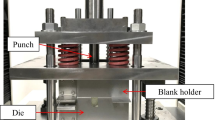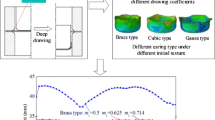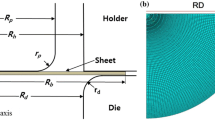Abstract
To improve the prediction accuracy of the crystal plasticity model, a procedure that adjusts the crystal orientation was proposed. This procedure optimizes crystal orientations such that the predicted R-values for the rolling, diagonal, and transverse directions coincide with the experimental results. The crystal plasticity simulation with the experimental/original texture predicted the experimental trend of R-value variation. However, the predictions deviated slightly from the experimental results. After adjusting the crystal orientations, the predicted R-values agreed well with the experimental results. In contrast, the texture adjustment slightly altered the flow stress anisotropy under uniaxial tension. Furthermore, the texture adjustment had little effect on the strain path and flow stress under biaxial stress states. Thus, texture adjustment improved the R-value prediction, and its influence on other properties was marginal. Subsequently, the deep drawing of the cylindrical cup was simulated using the crystal plasticity finite element method. The crystal plasticity model with the adjusted texture predicted the height and thickness of the cup better than the experimental texture. The R-value is an essential parameter that governs the cup height. Hence, texture adjustment based on the R-value improves the reliability of deep drawing simulations. The present study demonstrated the performance of the proposed texture adjustment procedure on the predictions of plastic anisotropy and sheet metal forming simulations.

















Similar content being viewed by others
References
Gotoh M, Ishise F (1978) A finite element analysis of rigid-plastic deformation of the flange in a deep-drawing process based on a fourth-degree yield function. Int J Mech Sci 20:423–435
Gotoh M (1977) A theory of plastic anisotropy based on a yield function of fourth order (plane stress state)—I. Int J Mech Sci 19:505–512
Hill R (1948) A theory of the yielding and plastic flow of anisotropic metals. Proc R Soc Lond A 193:281–297
Barlat F, Lege DJ, Brem JC (1991) A six-component yield function for anisotropic materials. Int J Plast 7:693–712
Barlat F, Brem JC, Yoon JW, Chung K, Dick RE, Lege DJ, Pourboghratg F, Choi SH, Chu E (2003) Plane stress yield function for aluminum alloy sheets—part 1: theory. Int J Plast 19:1297–1319
Barlat F, Aretz H, Yoon JW, Karabin ME, Brem JC, Dick R (2005) Linear transfomation-based anisotropic yield functions. Int J Plast 21:1009–1039
Hosford WF (1972) A generalized isotropic yield criterion. J Appl Mech 39:607–609
Chung K, Shah K (1992) Finite element simulation of sheet metal forming for planar anisotropic metals. Int J Plast 8:453–476
Yoon JW, Yang DY, Chung K, Barlat F (1999) A general elasto-plastic finite element formulation based on incremental deformation theory for planar anisotropy and its application to sheet metal forming. Int J Plast 15:35–67
Yoon JW, Barlat F, Dick RE, Chung K, Kang TJ (2004) Plane stress yield function for aluminum alloy sheets—part II: FE formulation and its implementation. Int J Plast 20:495–522
Yoon JW, Barlat F, Dick RE, Karabin ME (2006) Prediction of six or eight ears in a drawn cup based on a new anisotropic yield function. Int J Plast 22:174–193
Banabic D, Kuwabara T, Balan T, Comsa DS, Julean D (2003) Non-quadratic yield criterion for orthotropic sheet metals under plane-stress conditions. Int J Mech Sci 45:797–811
Banabic D, Aretz H, Comsa DS, Paraianu L (2005) An improved analytical description of orthotropy in metallic sheets. Int J Plast 21:493–512
Comsa DS, Banabic D (2008) Plane stress yield criterion for highly anisotropic sheet metals. Proc Numisheet 2008, Interlaken, Switzerland, pp 43–48
Vrh M, Halilovič M, Starman B, Štok B, Comsa DS, Banabic D (2014) Capability of the BBC2008 yield criterion in predicting the earing profile in cup deep drawing simulations. Eur J Mech A 45:59–74
Cazacu O, Plunkett B, Barlat F (2006) Orthotropic yield criterion for hexagonal closed packed metals. Int J Plast 22:1171–1194
Plunkett B, Cazacu O, Barlat F (2008) Orthotropic yield criteria for description of the anisotropy in tension and compression of sheet metals. Int J Plast 24:847–866
Soare S, Barlat F (2010) Convex polynomial yield functions. J Mech Phys Solids 58:1804–1818
Yoshida F, Hamasaki H, Uemori T (2013) A user-friendly 3D yield function to describe anisotropy of steel sheets. Int J Plast 45:119–139
Nakamachi E, Xie CL, Harimoto M (2001) Drawability assessment of BCC steel sheet by using elastic/crystalline viscoplastic finite element analyses. Int J Mech Sci 43:631–652
Nakamachi E, Xie CL, Morimoto H, Morita K, Yokoyama N (2002) Formability assessment of FCC aluminum alloy sheet by using elastic/crystalline viscoplastic finite element analysis. Int J Plast 18:617–632
Zhao ZS, Mao WM, Roters F, Raabe D (2004) A texture optimization study for minimum earing in aluminium by use of a texture component crystal plasticity finite element method. Acta Mater 52:1003–1012
Raabe D, Wang Y, Roters F (2005) Crystal plasticity simulation study on the influence of texture on earing in steel. Comput Mater Sci 34:221–234
Tikhovskiy I, Raabe D, Roters F (2007) Simulation of earing during deep drawing of an Al–3% Mg alloy (AA5754) using a texture component crystal plasticity FEM. J Mater Process Technol 183:169–175
Han F, Roters F, Raabe D (2020) Microstructure-based multiscale modeling of large strain plastic deformation by coupling a full-field crystal plasticity-spectral solver with an implicit finite element solver. Int J Plast 125:97–117
Shi Y, Jin H, Wu PD (2018) Analysis of cup earing for AA3104-H19 aluminum alloy sheet. Eur J Mech A 69:1–11
Barrett TJ, Knezevic M (2019) Deep drawing simulations using the finite element method embedding a multi-level crystal plasticity constitutive law: experimental verification and sensitivity analysis. Comput Methods Appl Mech Eng 354:245–270
Tang W, Zhang S, Peng Y, Li D (2009) Simulation of magnesium alloy AZ31 sheet during cylindrical cup drawing with rate independent crystal plasticity finite element method. Comput Mater Sci 46:393–399
Hama T, Hirano K, Matsuura R (2022) Cylindrical cup drawing of a commercially pure titanium sheet: experiment and crystal plasticity finite-element simulation. Int J Mater Form 15:8
Delannay L, Melchior MA, Signorelli JW, Remacle JF, Kuwabara T (2009) Influence of grain shape on the planar anisotropy of rolled steel sheets–evaluation of three models. Comp Mater Sci 45:739–743
Lebensohn RA, Tomé CN (1993) A self-consistent anisotropic approach for the simulation of plastic deformation and texture development of polycrystals: application to zirconium alloys. Acta Metall Mater 41:2611–2624
Van Houtte P, Li S, Seefeldt M, Delannay L (2005) Deformation texture prediction: from the Taylor model to the advanced Lamel model. Int J Plast 21:589–624
Zhang K, Holmedal B, Hopperstad OS, Dumoulin S, Gawad J, Van Bael A, Van Houtte P (2015) Multi-level modelling of mechanical anisotropy of commercial pure aluminium plate: crystal plasticity models, advanced yield functions and parameter identification. Int J Plast 66:3–30
Gawad J, Banabic D, Van Bael A, Comsa DS, Gologanu M, Eyckens P, Van Houtte P, Roose D (2015) An evolving plane stress yield criterion based on crystal plasticity virtual experiments. Int J Plast 75:141–169
Han F, Diehl M, Roters F, Raabe D (2020) Using spectral-based representative volume element crystal plasticity simulations to predict yield surface evolution during large scale forming simulations. J Mater Process Technol 277:116449
Yoshida K, Yamazaki Y, Nakanishi H (2021) Experiments and crystal plasticity simulations on plastic anisotropy of naturally aged and annealed Al–Mg–Si alloy sheets. Metals 11:1979
Rousselier G, Barlat F, Yoon JW (2009) A novel approach for anisotropic hardening modeling. Part I: Theory and its application to finite element analysis of deep drawing. Int J Plast 25:2383–2409
Toth LS, Van Houtte P (1992) Discretization techniques for orientation distribution functions. Textures Microst 19:229–244
Wu X, Ohno N (1999) A homogenization theory for time-dependent nonlinear composites with periodic internal structures. Int J Solids Struct 36:4991–5012
Ohno N, Okumura D, Noguchi H (2002) Microscopic symmetric bifurcation condition of cellular solids based on a homogenization theory of finite deformation. J Mech Phys Solids 50:1125–1153
Yoshida K, Okada N (2020) Plastic flow behavior of fcc polycrystal subjected to nonlinear loadings over large strain range. Int J Plast 127:102639
Hughes TJ (1980) Generalization of selective integration procedures to anisotropic and nonlinear media. Int J Numer Methods Eng 15:1413–1418
Kalidindi SR, Bronkhorst CA, Anand L (1992) Crystallographic texture evolution in bulk deformation processing of FCC metals. J Mech Phys Solids 40:537–569
Kallend JS, Kocks UF, Rollett AD, Wenk HR (1991) Operational texture analysis. Mater Sci Eng A 132:1–11
Matthies S, Wenk HR, Vinel GW (1988) Some basic concepts of texture analysis and comparison of three methods to calculate orientation distributions from pole figures. J Appl Cryst 21:285–304
Yoon JW, Dick RE, Barlat F (2011) A new analytical theory for earing generated from anisotropic plasticity. Int J Plast 27:1165–1184
Peeters B, Kalidindi SR, Teodosiu C, Van Houtte P, Aernoudt E (2002) A theoretical investigation of the influence of dislocation sheets on evolution of yield surfaces in single-phase BCC polycrystals. J Mech Phys Solids 50:783–807
Wen W, Borodachenkova M, Tomé CN, Vincze G, Rauch EF, Barlat F, Grácio JJ (2016) Mechanical behavior of low carbon steel subjected to strain path changes: experiments and modeling. Acta Mater 111:305–314
Rousselier G, Barlat F, Yoon JW (2010) A novel approach for anisotropic hardening modeling. Part II: Anisotropic hardening in proportional and non-proportional loadings, application to initially isotropic material. Int J Plast 26:1029–1049
Noh D, Yoon JW (2020) Reduced texture approach for crystal plasticity finite element method toward macroscopic engineering applications. IOP Conf Ser: Mater Sci Eng 967:012071
Funding
This work was financially supported by JSPS KAKENHI Grant Number 19K05078.
Author information
Authors and Affiliations
Corresponding author
Ethics declarations
Conflict of interests
We declare no conflict of interest.
Additional information
Publisher's note
Springer Nature remains neutral with regard to jurisdictional claims in published maps and institutional affiliations.
Rights and permissions
Springer Nature or its licensor holds exclusive rights to this article under a publishing agreement with the author(s) or other rightsholder(s); author self-archiving of the accepted manuscript version of this article is solely governed by the terms of such publishing agreement and applicable law.
About this article
Cite this article
Yoshida, K., Honke, T., Yamazaki, Y. et al. Adjustment of crystal orientations and application to crystal plasticity simulation of cup drawing. Int J Mater Form 15, 68 (2022). https://doi.org/10.1007/s12289-022-01713-4
Received:
Accepted:
Published:
DOI: https://doi.org/10.1007/s12289-022-01713-4




